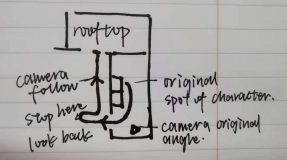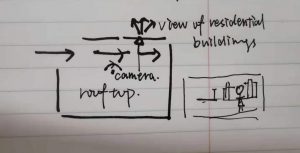Controlled city: Creating Rooftop
During the pandemic time, every public space is under strict control, leading to the disappearance of many daily narrations. While rooftop, as a place between private and public space, might be “created” in a new narration.
Footage & Drawings
[Act I]
Scene A (15s): Dormitory (Start with Black screen, the sound of typing, clicking the mouse, and background music)
Jane is crouching in the chair, wearing earphones, and surfing the website when she notices the news that “West and Central District Harbor will be shut down temporarily because of the anti-pandemic requirement of government”, She sighs, picks up the mask on the table, puts it up and goes out with the cloth basket.

Scene B (20s) : Interview 1 (Classroom/Corridors) (Music volume down)
Question: Have you been to the rooftop of the building you live in?
(Possible answers) Answer 1: I do know there is one, but never been to
Answer 2: When I first move in, I hang the quilt and pillows out there, but since then I seldom go, I mean, what’s wrong with the drying machines?
Answer 3: do university halls have rooftop balconies?
[Act II]
Scene A (10s): Laundry (The noise in the laundry and background music in normal volume)
After putting the last piece of clothes into the washing machines, Jane walks out of the laundry room and notices that the door to the rooftop balcony is open. She steps on the doorsill and looks out at the balcony. (Scene from the perspective behind the door) (Music stops, cut to the first interview)

Scene B (25 s) : Interview 2 (Classroom/Corridors) (Music volume down)
Question: What do you think can be done on the rooftop?
(Possible answers) Answer 1: well… maybe hanging clothes?
Answer 2: in the movie, we see people may shout loudly on the rooftop but I think it is impossible for us because of the surrounding residential building lol
Answer 3: It can be very dangerous to go there during the examination period you know.
Answer 4: BBQ and drinking beer?
[Act III]
Scene A (15s): Rooftop Balcony (Music volume normal)
Jane walks out into the balcony, wandering around (like making sure there is nobody). Standing close to the handrail, she stared at the light from the opposite building. She takes off the earphone and turns up the voice. (Music version change) (After a while, hesitantly) She takes off the mast. (Music stop)

Scene B (25s): Interview 3 (Classroom/Corridors) (Music volume down)
Question: Would you like to hang out with your friend on the rooftop?
(Possible answers) Answer 1: oooooh you remind me that might be a really good replacement for seaside
Answer 2: I am not sure, because it is not public and my friend cannot come in, so I think at most
Answer 3: Is that really legal to take off a mask during the pandemic? (Music stop)
[Ending]
Scene A (5s): Rooftop Balcony & Seaside (Music volume normal)
Jane and Starry: Leaning at the handrail, chatting.
Title: “The Controlled City: Creating Rooftop”
Credit List (End)
Credit:
Produced/Written/Directed by CHEN Quanchi
Casted by CAI Heqi, CHEN Yimei, CHEN Quanchi, DAI Zehui, KWON Yeung Fong, LIN Chun Ming, WANG Sinan, XIAO Jingzhou,
Photographed/Edited by CHEN Quanchi
Background Music: 帶我去找夜生活-告五人;帶我去找夜生活(健康版)-告五人
Transcript:
Micheal de Certeau(1984) argued that the social space is related to narration and no space can be structured without boundary. During the pandemic time, there are more “boundaries” than ever, not only long-time physical quarantine but also possible psychological estrangement. When public space continuedly closed down due to pandemic control, what people lost might more than the places for leisure and entertainment, but the narration embedded in the space. But, can we create another space by changing existing boundaries and imagining a new narration?
The original idea of the video is more about my personal experience and perception of the hall rooftop. During the time when the pandemic was most serious, I was trapped in the rather empty hall and not able to hang out with friends. Once after I went to the laundry, I found the door to the rooftop balcony open. When I standing on the rooftop, hearing the mixed sound from washing machines, traffic, and music, watching the light from a nearby neighborhood, a complex sense of loneliness and freedom. Therefore, part of my research is a qualitative study, which intends to investigate whether other people share this feeling and their ideas on the possible narration on the rooftop. I invited 7 fellow students to a short interview and recorded their responses with consent. The result shows that many have never been to the rooftop of their residence, making the rooftop a considerably strange space in their daily life. However, they are quite familiar with the general symbolic meaning of rooftop narration, including swimming pool, singing, and barbecue. When asking if they want to spend time with friends on the rooftop, they seem willing to do so but also concern about the pandemic situation. For literature research, I try to relate some scholars’ ideas with the character’s story. For instance, at the last of Act III Scene A, she takes off the mask, which can be considered as a perceptional crossing of boundary—from public to more “private” space. This is probably delinquency because of pandemic policy but is allowed because of the body’s non-inscription into the text of newly-discovered rooftop order. (De Certeau, 1984) In the last scene, the character and her friend chat on the rooftop, which symbolic of the process of creating new narration or creating the rooftop space.
The two research discourses are parallel mixed in the video essay, more like the form of the film trailer. The only background music is “Take me to find nightlife” and there are two versions, one more soothing and another more rhythmic. The altering of the music version and the filter color from cold to warm when the character takes off her earphone indicates the possible crossing of “boundary” and the change of her mindset after finding the possibility of new nightlife narration on the rooftop—a place probably not that controlled in the “controlled city”.
The demonstration might be better if I have better photograph skills. Through the creation of this video, I hope to imply that lively narration and vibrant places can be created, even during the hard and lifeless time. Like one of the interviewees mentioned that the sunset view on the rooftop helps people relax, in the controlled city, we can find comfort through our initiative. After all, it always requires efforts to live better.
Bibliography(APA):
AlSayyad, N. (2006). Voyeuristic Modernity: the Lens, the Screen, and the City. In Cinematic urbanism: A history of the modern from reel to real (pp. 147-168). New York: London: Routledge.
De Certeau, M. (1984). Walking in the City. In Randall, S. (Trans.) The Practice of Everyday Life (pp. 91- 110). Berkeley: University of California Press.
De Certeau, M. (1984). Spatial Stories. In Randall, S. (Trans.) The Practice of Everyday Life (pp. 115- 130). Berkeley: University of California Press.
Friedland, R. & Boden, D. (1994). NowHere: An Introduction to Space, Time and Modernity. In R. Friedland and D. Boden (Ed.) NowHere: Space, Time and Modernity. (pp. 1-60) Oakland: University of California Press
Gieryn, T. (2000). A space for place in Sociology. Annual Review of Sociology, 26, 463-96.
Simmel, G. (1971). The Sociology of Space. In D. Frisby & M. Featherstone (Ed.) Simmel on Culture: Selected Writings. (pp.137-185) Chicago: University of Chicago Press.
CHEN QUANCHI 3035637395
Your expository video is very enjoyable to watch! I also liked how you use the interviews as a way to narrate your story. In addition, you also did a well-crafted reflection on the concepts we have discussed throughout the semester.
You mentioned how the idea for your video originated from your own experience. Showcasing (or even maybe contrasting, or resonating) your experience to your interviewees’ point of views could also strengthen your argument. What were the most surprising things that you discovered throughout your research process, particularly the interview? Were they aligned to your hypotheses? In what way? If not, what might be the case? Although it is not a matter of who is right and who is wrong, you could use this contrasting argument as a new starting point for your further inquiry!